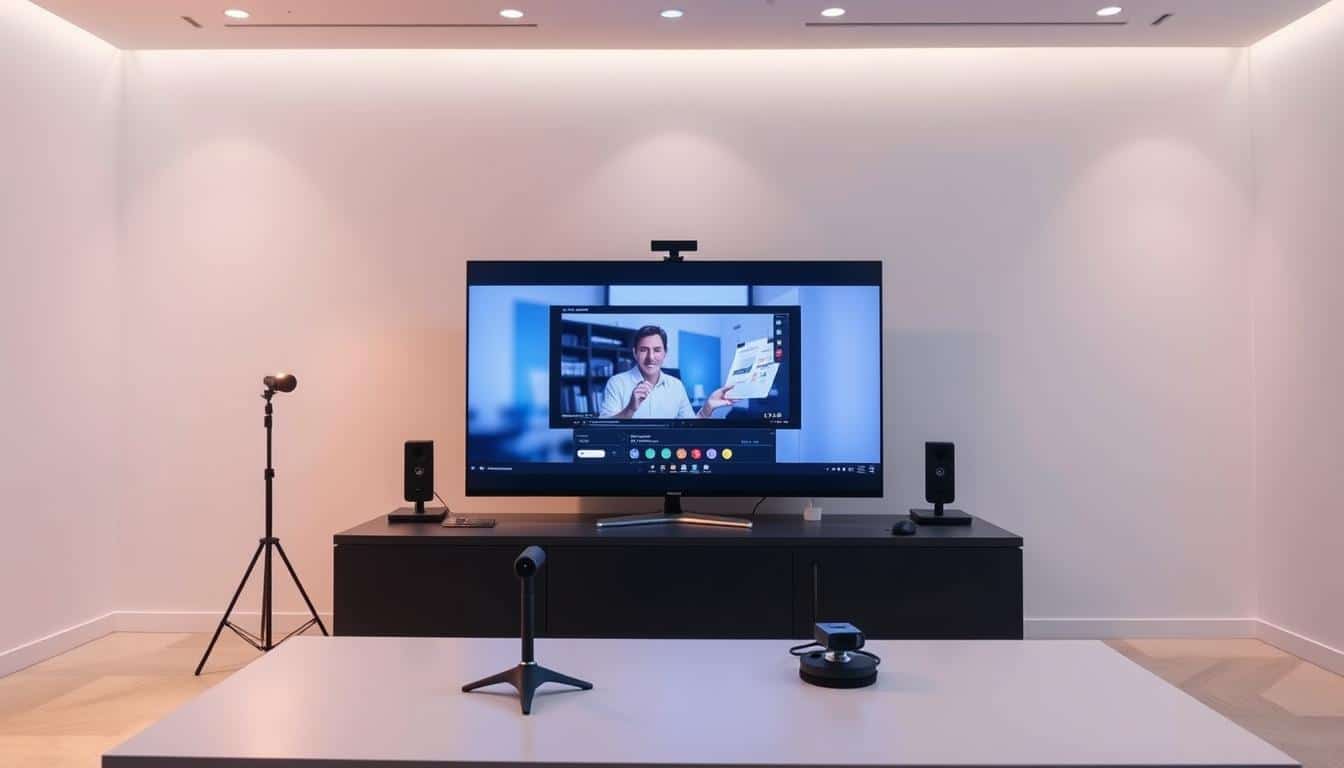Anúncios
In today’s world, good virtual meetings are key for great teamwork from afar. Learning how to handle online talks well is important. It makes meetings work better and keeps everyone interested. This piece looks into tips to make virtual meetings better. It offers helpful steps to make meetings useful and to the point.
Having a clear agenda sent out before the meeting helps a lot. Keeping meetings short and focused is also crucial. Every tip is important to make communication better. By setting clear roles and using tools that make the meeting interactive, meetings become more about working together. This teamwork then leads to decisions that work well.
Anúncios
Understanding Virtual Meetings
Virtual meetings are online gatherings that let people meet from different places at the same time. They’ve become more crucial as more organizations adopt hybrid work models. They keep teams connected, help with working together, and make sure people can talk effectively even when they can’t meet face to face.
Definition and Importance
Virtual meetings have many uses and can really improve how a workplace functions. Knowing what these meetings are can help organizations pick the best way to meet. These online gatherings are key to making sure everyone in the team can share ideas and participate. Stressing their importance can lead to better work and happier employees.
Different Types of Virtual Meetings
Knowing the different kinds of online meetings helps make each one more effective. Here are some common types:
- Video Conferences: Facilitate face-to-face interaction through video feeds.
- Web Conferences: Allow for collaborative sessions with screen sharing and presentations.
- Webinars: Primarily educational, designed for larger audiences with an emphasis on presenting content.
- Teleconferences: Focus on audio interactions, suitable for discussions without the need for visuals.
- Huddles: Short, informal meetings for quick updates and check-ins.
Choosing the best format can boost participation and help reach goals, showing why it’s vital to understand the different types of online meetings in today’s digital workplace.
Why Implement Virtual Meeting Best Practices?
Using the best practices for virtual meetings can boost online work efficiency and productivity. Many challenges come with virtual meetings, yet knowing their benefits can solve these issues and improve communication. This focus helps teams create a productive and engaging online workspace.
Benefits of Effective Virtual Meetings
Virtual meetings let people from around the world connect easily, which means more collaboration and access. Here are some key benefits:
- Global participation, enabling diverse perspectives.
- Real-time document sharing, promoting in-depth discussions.
- Recording capabilities, ensuring that valuable information is preserved for those unable to attend.
- Interactive tools like polls and breakout sessions, which can boost engagement.
These points show how virtual meetings can play a big role in a company’s success.
Common Challenges Faced
Even though virtual meetings have many benefits, they also come with challenges that can affect how good they are. Some common issues include:
- Technical difficulties, such as connectivity issues or software glitches.
- Distractions at home, making it harder for participants to maintain focus.
- Miscommunication caused by the lack of in-person cues, which can lead to misunderstandings.
- Maintaining engagement, especially during lengthy discussions.
It’s vital to know these challenges to have better meetings. By doing this, companies can get more done and enjoy the big benefits of online meetings.
Preparing for a Virtual Meeting
Getting ready for successful virtual meetings is very important. You need to set a clear plan. This includes making a detailed agenda and picking the right tech. This way, everyone can participate well and reach the goals.
Creating a Detailed Agenda
Making a good agenda is like drawing a map for your meeting. It shows what will be talked about. Make sure to focus on the main points and explain the goals for each one. Also, give this agenda to everyone before the meeting so they can get ready.
Telling people who is responsible for each agenda item helps keep the meeting on track. It makes sure time is used well.
- Share short biographies of team members to foster understanding of expertise and cultural orientation.
- Establish meeting protocols and rules of engagement before starting.
- Limit meetings to 30-60 minutes and restrict participants to 6-8 to encourage interaction.
Give out materials before the meeting and make sure everyone looks at them. This helps everyone join in and get things done during the meeting.
Choosing the Right Technology
It’s key to pick the right technology for virtual meetings. Look at different options and their features. Think about what works best for screen sharing and chats. Zoom and Google Meet are easy for talks. Microsoft Teams is great for working on documents together. Everyone must know how to use the chosen tech.
Always have a backup plan in case there are tech problems. Letting everyone know this plan makes them feel ready. The tech you use should help you meet your goals.
Key Virtual Meeting Best Practices
Implementing the right strategies can make your virtual meetings more productive and engaging. It’s important to test your meeting setup, have a plan if things go wrong, and make sure everyone feels included. Doing these things helps everyone stay connected and contributes to the success of the meeting.
Testing Equipment Ahead of Time
Testing your gear before the meeting is key. This includes checking your microphones, cameras, and internet connection. Doing so helps avoid any technical problems that could interrupt the meeting. Use different tools to ensure everything works well for a smooth meeting experience.
Setting Up a Backup Communication Plan
It’s smart to have a backup plan for communication. If technical issues happen, you can use phones or texts to stay in touch. This plan means your meeting can go on, even if there are internet problems.
Ensuring All Participants are Engaged
To keep everyone involved in a virtual meeting, use engaging techniques. Ask people to turn on their audio and video to make the meeting more interactive. Use chats, polls, or tools for working together to get feedback and keep everyone interested. By involving everyone actively, your meeting can become an exciting exchange of ideas.
Creating an Inclusive Meeting Environment
To make everyone work well together, even from far away, we need inclusive meetings. Making sure every participant feels important is key. This includes using tech smartly and considering everyone’s time zone.
Encouraging Camera and Microphone Use
Turning on cameras and mics makes meetings feel more real. It lets us see and understand each other better. Also, ask everyone to share their pronouns and if they need any special help in the invite. Making clear how everyone should use video and chat helps too. Remind folks to mute when they’re not talking to keep the audio clear.
Handling Different Time Zones and Locations
Organizing meetings for people in different places can be tough. It’s important to find times that work for most people. Changing up meeting times and using tools that show different time zones can help everyone join in. Giving out materials early means no one misses out. Also, using chat or emails afterward lets everyone take part, no matter where they are.
Effective Facilitation During Meetings
The role of a meeting facilitator is crucial for successful virtual meetings. This person ensures discussions flow well and everyone gets involved. They set the tone, encourage everyone to speak up, and keep things on track. By using engaging slides or images, they keep everyone interested.
Role of the Meeting Facilitator
A skilled facilitator manages the conversation to make sure everyone is heard. They send out connection info and materials early, so people can prepare. Setting ground rules in chat ensures respect. They use tech to share videos, chat, and screens, meeting various goals. Good audio gear and muting lines cut down distractions, keeping communication clear.
Engaging Participants and Limiting Side Conversations
Effective meetings need strategies to work together and avoid disruptions. Using hand signals helps manage talks. Timeboxing items keeps the meeting on schedule. Collaborative tools, like Google Docs, improve note-taking and focus. Only list main topics on the agenda to keep it clear and note when breaks are happening, especially in long meetings.
Enhancing Interaction in Virtual Meetings
Creating a dynamic atmosphere in virtual meetings can boost engagement and interaction. By using interactive tools and steps, along with icebreaker activities, the experience becomes more collaborative.
Utilizing Interactive Tools and Features
Meetings are better with lively virtual tools that support real-time participation. Tools like Slido and Mentimeter offer live polling for quick feedback, making sessions interactive with quizzes and word clouds. Platforms like Miro or Microsoft Whiteboard encourage brainstorming, where everyone can share ideas visually.
Getting participants to introduce themselves makes the atmosphere welcoming. Using names when asking for input boosts involvement. It’s vital to pause often so people can ask questions or share thoughts. This way, everyone feels included, strengthening the community.
Incorporating Icebreakers and Fun Activities
Starting with icebreakers like “Two truths and a lie” or fun questions eases tensions. It helps people relax and connect. Breakout rooms for small talks encourage more active and personal interactions.
Allowing camera use boosts the connection, but it’s optional. Hand-raising, emojis, and polls make the meeting lively. Remember to keep the chat active with comments and questions to keep the conversation going.
Post-Meeting Best Practices
After a virtual meeting, following up quickly is crucial for success. Actions taken after meetings make work more organized. Knowing what is expected makes everyone clearer on their duties, improving the meeting’s results.
Sharing Action Items and Key Takeaways
It’s important to send out a summary with key points and tasks after the meeting. In follow-up emails, highlight the discussion, actions to take, and their deadlines. This keeps everyone on track and makes sure nothing is missed. Consider using tools like Monday or Trello to keep track of tasks. They help manage the workload and update team members efficiently.
Gathering Feedback from Participants
Asking for feedback is key to improving meetings. You can talk to team members informally or use surveys to get their thoughts. This helps understand what worked and what didn’t. Collecting feedback makes everyone feel involved and helps make future meetings better. It shows you value their input and want to meet their needs.
Addressing Common Virtual Meeting Issues
Virtual meetings have their own set of challenges. These problems can affect how well we work together and share ideas. It’s important to tackle these issues head-on to keep communication and teamwork strong. Solutions exist for dealing with technical problems and the fatigue from too many video calls.
Dealing with Technical Challenges
Technical troubles are common in meetings. You might face weak internet connections, annoying echoes, or microphones that don’t work well. These issues can interrupt the meeting and make people feel frustrated. By checking your equipment before the meeting, you can avoid many of these problems.
Make sure everyone knows the right settings to use. This step can prevent many technical issues. Also, having a backup way to connect can keep your meeting running smoothly if problems pop up.
Overcoming Video-Conference Fatigue
Feeling tired from too many video calls is a real problem now. Having long meetings can make it hard for people to stay focused. To make things better, try to have shorter meetings and put breaks in them. It also helps to turn off the camera now and then to relax a bit.
Avoid scheduling meetings one right after another. This can help everyone stay sharp and engaged. Creating a lively and interesting meeting space can make a big difference. It makes meetings more productive and enjoyable for everyone.

Virtual Meeting Etiquette for Participants
Practicing proper virtual meeting etiquette is essential for all participants. Keeping a professional look and minimizing distractions helps create a productive meeting space.
Maintaining Professional Appearance and Setting
Dressing professionally for meetings is crucial. Looking neat shows professionalism and sets the discussion’s tone. Here are tips for looking your best online:
- Choose clothing that aligns with the professionalism of your workplace.
- Ensure your surroundings are tidy and distraction-free.
- Position your camera to frame your face clearly.
- Keep your camera on during the meeting, especially during interactive sessions.
- Arrive early to test equipment and relax before the meeting begins.
Notifying the Group of Distractions
It’s key to handle distractions well during virtual meetings. If you expect interruptions, inform the group ahead of time. Here are ways to keep distractions at bay:
- Mute your microphone when not speaking to minimize background noise.
- Be aware of potential noises such as pets or household appliances.
- Avoid multitasking, such as checking emails or texts, to stay focused.
- Use the chat function for questions or comments to avoid disrupting the speaker.
- If needed, set clear goals and agendas to keep everyone on track.
Conclusion
Reliance on apps like Microsoft Teams for remote communication has changed how we meet online. Planning well by picking the right tools and protecting privacy is crucial. It helps make virtual talks engaging.
Virtual meetings are now a big part of our workdays. Following good practices makes them more productive and fun. Testing tech ahead of time and having a clear plan are key steps.
How we end meetings is important too. Summing up decisions and who will do what helps save time. It makes everyone feel they achieved something. In the end, these practices turn regular online meetings into great chances for teamwork and progress.
FAQ
What are the key benefits of effective virtual meetings?
How can I ensure participants stay engaged during a virtual meeting?
What are some common challenges in virtual meetings and how can they be addressed?
How should I prepare for a virtual meeting?
What tools can enhance interaction in virtual meetings?
How can I keep a professional atmosphere in a virtual meeting?
What best practices can help overcome video-conference fatigue?
How can feedback improve future virtual meetings?
How do I schedule meetings with participants in different time zones?
What role does the meeting facilitator play in virtual meetings?
Conteúdo criado com auxílio de Inteligência Artificial



